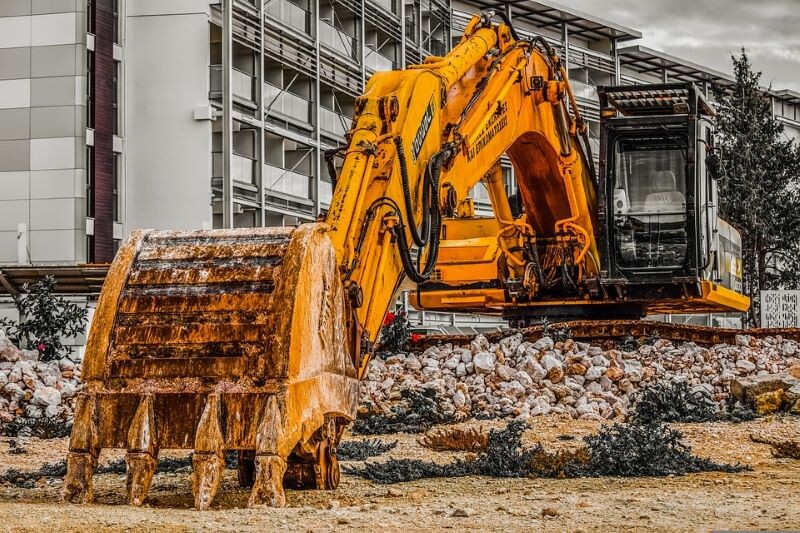
Once you’ve chosen the right digger to suit your needs, it’s worth considering whether your project could benefit from the use of a versatile digger attachment. From augers to mini digger breaker attachments, there are so many handy add-ons to choose from, all of which strive to make your job as straightforward as possible. Here, we examine the most popular digger attachments and their uses, from buckets to hydraulic breakers.
At C&C Hire, we’re pleased to offer our customers a range of mini digger attachments for hire. If you would like to find out more about any of the products featured in our extensive fleet, please get in touch. Call us on 07985 160 968 and speak to one of our knowledgeable team members today.
Auger Attachment
The auger is an industry-favoured digger attachment, used to drill holes for pipes and poles. Available in a range of lengths and dimensions, from 2 to 18 inches, an auger has multiple uses on site.
How Does an Auger Work?
The top of an auger is called the tang and attaches to the digger. The tang is then secured to the shank which is the section between the tang and the blades. The auger works by rotating into the ground, using its blades to cut and clear the path for a hole. The cutting tip, feed screw and spur are located at the bottom of the auger and are most commonly found in smaller augers.
How is an Auger Used in Construction?
There are many reasons why you might need to use an auger in construction. These include drilling holes for:
- Fence/telephone poles
- Building foundations
- Planting trees
In most cases, an auger used in construction will be used to dig into soil, dirt or the ground.
When Might I Need to Hire an Auger?
Whether you’re completing a small landscaping project or are working on a large-scale construction site, it’s worth considering how hiring an auger could make your job easier. If you’re planning to drill holes for fences, plant trees, or put in a deck foundation, you would likely benefit from hiring this adaptable mini-digger attachment. At C&C Hire, we’re pleased to offer our customers an auger drill attachment for the 1.5-tonne mini digger. If you’d like to find out more about this useful piece of construction machinery, please get in touch.
Digger Bucket Attachment
A bucket is one of the most common digger attachments used by professionals. Able to assist in a multitude of tasks, digger buckets are available in a range of sizes to fit both mini and large diggers.
Types of Digger Buckets
The most common buckets used on construction sites are:
Digging bucket
Equipped with short teeth, digging buckets can be used to perforate the ground. Ideal if you’re working with dirt, soil, gravel or sand, the standard digging bucket is favoured by the majority.
Trenching bucket
Designed for trench digging, this digger attachment is perfect for tasks like piping and drain digging. With a narrow design and sharp blade, these buckets can easily dig through dense materials.
Grading bucket
Featuring smooth edges that work well with soft materials, grading buckets are a popular choice for loading and unloading materials. Favoured by landscapers and construction workers, this digger lifting attachment is most suitable for fragile work.
Heavy-Duty bucket
Made using strong steel, the heavy-duty bucket is ideal if you’re working in extreme conditions. Able to extract a range of dense materials, from granite to compact clay, this digger attachment is perfect for complex projects.
How To Choose the Right Digger Bucket For You
When picking the right digger bucket for your project, it’s important to first consider the type of digger you’re using and the materials you’re working with. You also need to carefully analyse the density of the ground you’re penetrating. The harder the ground the sharper the puncture will need to be.
Hydraulic Breakers
When an unexpected obstacle prevents you from being able to effectively carry out a dig, hydraulic breakers offer the ideal solution. Able to chip away at large boulders, this mini-digger breaking attachment is the perfect addition to any site.
How Does a Hydraulic Breaker Work?
A hydraulic breaker usually consists of three key components: a cylinder, a piston and a control valve. Hydraulic oil is supplied to the breaker through the main valve in the cylinder. In order to penetrate the ground, the pressure in the upper chamber is released through the outlet. The piston moves up and down, hitting the material, while the valve rotates to control the oil flow.
What Are the Advantages of Hiring a Hydraulic Breaker?
- Superior efficiency
- Energy saving capabilities
- Low vibration/ noise pollution
- Easy to operate
- Highly accurate
Uses of a Hydraulic Breaker
The uses of a hydraulic breaker might seem obvious, however, there are multiple settings in which this digger attachment may prove to be useful. These include:
- Demolishing buildings
- Quarrying
- Building roads
- Landscaping
At C&C Hire, we’re pleased to offer our customers a range of hydraulic breakers for hire. Our mini-digger breaking attachments are suited to a variety of projects, offering superior efficiency and performance. If you’d like to find out more about any of the digger attachments we stock for hire, please get in touch. Call us on 07985 160 968 and speak to one of our expert team members today.
